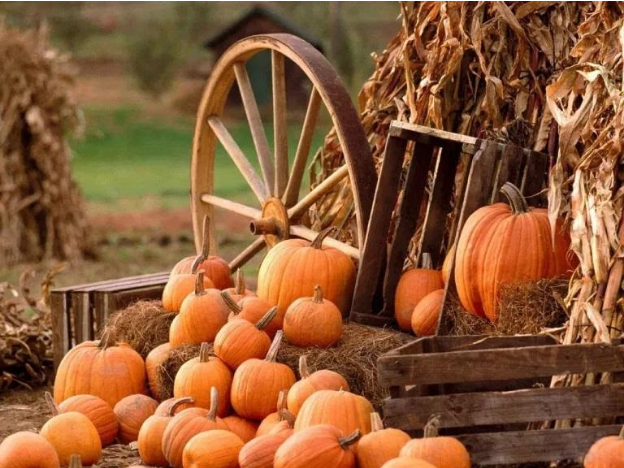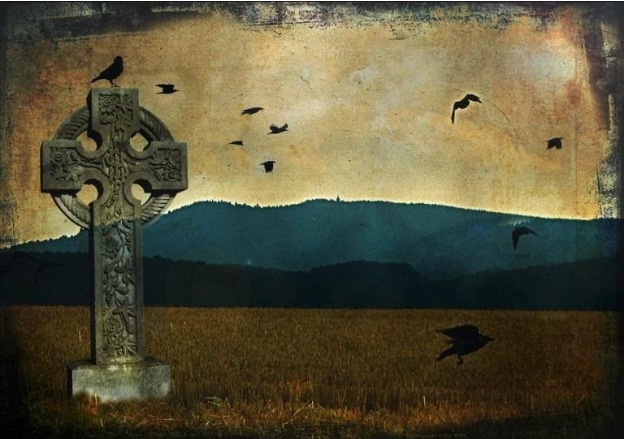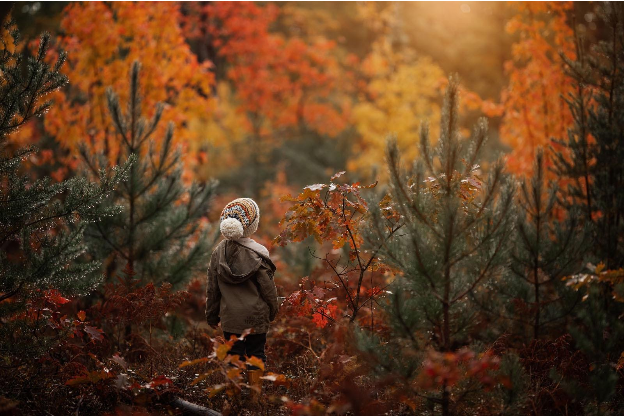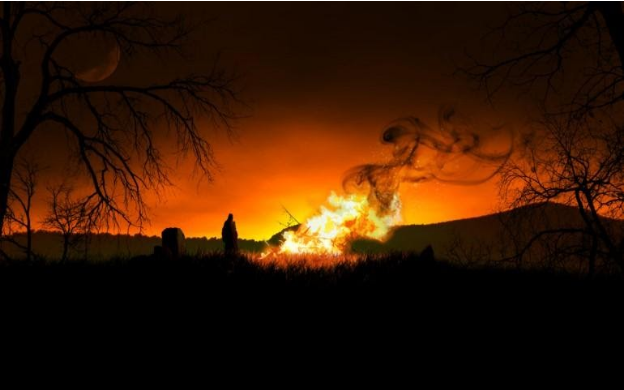 2,390 words
2,390 words
I cannot speak for the rest of the world, but for those of us who grew up in the United States, especially in its more rural environs, autumn is a particularly nostalgic season. In part, this is owing to associations formed during childhood: the forest ramblings, the fallen leaves crunching underfoot, the morning fog over the trees, the smell of woodsmoke in the air; the pumpkin patches and hayrides, county fairs and bonfires — all of these thoughts and remembrances come back to us in this season, tinted in shades of red and gold.
Beyond its purely personal associations, autumn has always struck me as a season of special significance to heritage Americans. This may be because the foliage on our Eastern seaboard, among the colonial hamlets of New England and the Tidewater, is among the most brilliant in the world. It could be because the fruits of the harvest most typically associated with autumn — corn and apples, squash and pumpkins — are representative of America’s agrarian tradition. The feast of Thanksgiving, of course, is a cornerstone of the traditional American identity, however adulterated it might have become in recent years. And the festival of Hallowe’en, one of the most popular holidays in America, traditionally signifies the beginning of the three-day Allhallowtide: a time for remembering the saints and ancestors that came before us, the mystical union between the Church Militant on Earth and the Church Triumphant in Paradise.
Most scholars believe that Halloween practices have their origin in the ancient Celtic festival of Samhain, which marked the end of the harvest season. It was considered a liminal time, when the boundary between the human world and the Otherworld was thin and easily crossed. Spirits of the ancient gods and fairies would enter into the mortal realm and required propitiation in the form of food and drink. The souls of departed ancestors would cross the threshold and return to their homes, and it was customary for their living descendants to set places for them at the table and beside the fire. Bonfires were lit on Samhain, as they were believed to have protective powers against the evil spirits and the approaching darkness. This was also a time when many animals were slaughtered in anticipation of the coming winter.
Many of these traditions remain intact in contemporary celebrations. The customs of “mumming” and “souling,” which arose in the medieval and early modern British Isles, are the likely origins of the contemporary American practice of trick-or-treating. Celebrants would go door-to-door singing and offering prayers for the dead in exchange for food, particularly soul cakes (a spiced biscuit marked with a cross). They would don masks and costumes either to impersonate the souls of the dead or to disguise themselves from them. The custom of carving jack-o’-lanterns is believed to have originated in Ireland as a means of warding off evil spirits — though in the old world it was turnips that were carved, rather than the indigenous American pumpkin.

Divination rituals were also popular at the time of Samhain, involving the use of apples and hazelnuts (associated with immortality and divine wisdom, respectively). This association of the holiday with apples is partly due to the intermingling of Roman and Celtic customs in the first century. The Roman festival of Pomona, goddess of orchards and the harvest, fell on November 1 and its customs eventually merged with those of the Celtic Samhain. The game of bobbing for apples began as a British folk tradition: unmarried youths would take turns trying to bite an apple floating in water without the use of their hands, and the first person to do so would be the next to marry.
Due to the themes of ancestor worship and the approaching darkness, it is fitting that many traditional Halloween customs center around death and remembrance. The Allhallowtide is a time for the contemplatio mortis, as the omnipresent depictions of graveyards, ghosts, and skeletons serve as a constant reminder of our mortality. This memento mori is present even in the most vulgar of horror films and contemporary haunted house attractions, and at its highest serves to remind us of the significance of life in the face of death.

The Celts, it is said, regarded this day as the beginning of the new year. It is a fitting commentary on the grim ethos of these northern European tribes that their year began, not with the efflorescence of springtime, but with Samhain, “summer’s end,” when the Earth prepares itself for the long slumber. It is born of the recognition that life begins in death, that what has grown old and decayed must pass away in order that spring may come again — that this is the greatest wisdom of nature, the secret to its eternally recurring beauty. Acknowledging the necessity of this death and dormancy is an affirmation of life, even in its tragic aspects. This is perhaps the primary reason for the inescapable melancholy of this season, extending throughout autumn and into the Yuletide.
As a mood, melancholy is distinct from depression. Melancholia is one of the four classical temperaments, associated with the planet Saturn, the affliction of scholars and thinkers. It was also, appropriately, associated with autumn, both the season as well as the symbolic period of late middle age in a man’s life. Melancholy is rooted in the acknowledgment of human finitude. The realization that we cannot know all, have all, be all; that limitations have been placed upon our attainments by history, family, temperament, and fate (perhaps all aspects of the same thing). This is the tragedy of the human condition, that our reach continually exceeds our grasp. Some would say that it is this very tragedy, the limitations imposed by our mortality and finitude, that gives our lives meaning.

Interestingly, in ancient medicine, the melancholic temperament was strongly associated with the function of memory: as the seventeenth-century botanist, physician, and astrologer Nicholas Culpeper wrote, the purpose of memory “is to record things either done and past, or to be done. It is [in] quality cold and dry, and melancholick, and therefore generally melancholick men have the best memoires. . . It is under the dominion of Saturn, and is fortified by his influence, but purged by luminaries.” A propensity to melancholy seems particularly characteristic of Faustian mankind, a recurring feature in the painting, literature, music, and philosophy of the West. In Spengler’s analysis, this melancholy takes two distinct forms: a yearning for infinity, to “be alone with limitless space,” to overcome the limitations of the human condition; and, contrariwise, a deep and pervasive nostalgia, “the wistful regard of the Faustian soul for ruins and evidences of the distant past.”
Those of a Rightist leaning are often accused of nostalgia, of perpetual dissatisfaction with the present and a longing to live in the past. It is true, as critics never tire of pointing out, that an excessive yearning for a lost Golden Age can easily lead to self-deception and paralysis in the face of an ever-changing reality. Certain segments of the New Right confront this charge by eschewing sentimental nostalgia altogether, looking to the past for guidance but nevertheless focusing resolutely on the future.
However, there are times when nostalgia can be a healthy, appropriate, and indeed wholesome emotion. The etymological root of nostalgia is an acute longing for nostos, homecoming. Home is not only a place. It can be a person, an object, a season, a song or a taste or a scent, even an idea. Tree limbs in the moonlight, forests and mountains shrouded in mist, Gothic churches and medieval castles. Memories of childhood — the happy ones, at least, hazy and sepia-tinted. Ringing church bells, Chopin nocturnes, falling water, the song of the mourning dove. Woodsmoke, incense, pine needles, autumn rain. In a broader sense, this desire for homecoming takes both a spiritual form, a yearning for a timeless reality transcending human experience, as well as a more concrete manifestation, longing for the restoration of an organic and natural social order.
This is not mere antiquarianism or sentimental longing for what is irrevocably lost. Nor is it impotent romanticism. Nostalgia is a visceral mood and, in its truest sense, represents a longing for a state of being, a state of wholeness. Nostalgia does not signify merely the pleasant memory of things past but the longing for a time when we were closer to the primordial. The wholesomeness and wonder of the child is probably the closest man can get in this life to that elemental purity. We feel nostalgia for childhood because this was the time when our experience of things was least adulterated, when we felt the greatest joy in simple existence, before our souls became fragmented; a memory of that original nobility and all the high ideals we held before the yawning corruption of adulthood set in. This is why “you can never go home again.” Attempting to recreate the scenes and experiences of childhood, without the proper state of mind, inevitably ends in vulgar kitsch and disappointment.

Despite its wistful connotations, nostalgia can serve a restorative function, reconnecting us with a past that is personal, familial, and world-historical. Visiting places, telling stories, and reveling in the sights, sounds, and myths of the path (personal and communal) can help us recover our purity of mind and purpose. It can also impart the strength to continue struggling to recover the essence of this mythical Golden Age in the present. As Evola wrote, “Some men return to their past, so that new forces may arise for the reconquest.”
But it is nevertheless true that nostalgia can be a harmful impediment to action. If it does not serve to restore our strength for the battles ahead, if it instead only leads us to wallow in impotence and futile longing for days past, then it is functionally no different from alcohol, drugs, or any other form of narcotics. Returning to the scenes of childhood, or histories of a nobler time in order to recapture the purity and vigor and beauty of those days is likely quite beneficial. Relying on the memories of an idealized past to fill a void in the present is certainly the opposite. Nostalgia risks turning into futile reminiscence unless it is tethered to a vision of the future, a realization that we are preserving the memories of the past in order that they might inspire us and guide us in carrying on what is best in it. To defend tradition is not to preserve the ashes, but to pass on the flame.
Respect for the past, willingness to learn from it and adapt its truths to the present, and affirming life in spite of the tragedy of human finitude is a defining trait of the True Right. It sets it apart from both the progressivism that rejects the lessons of history (because “formerly all the world was mad”) as well as the conservatism that merely wishes to maintain the status quo. Nietzsche observed that the romantic German philosophy of his day — the contemporary iteration of the perennial philosophy — seemed to him “the most fundamental form of romanticism and homesickness there has ever been: the longing for the best that ever existed” (Will to Power, section 419). Perhaps this is an accurate description of what is best in philosophy, which attempts to show mankind where it went wrong and point us in the right direction.
In short, while certain types of nostalgia can indeed be paralyzing, remembering and honoring where we came from is essential to knowing where we are going. The politics of the Right isn’t just about shining cities and space colonies. It requires learning and seeking renewal from the past, both social and personal. Like Nietzsche’s German philosophy, it must be a nostalgia for the best that has ever existed — for in truth our Restoration does not merely wish to turn back the clock to the 1950s, or the seventeenth century, or the twelfth century, or even the fourth century B.C., but to combine all that is best in Western governance and culture going back to the earliest societies. This synthesis is the meaning of the Golden Age, which exists not exclusively in historical reality but in those inherited ideals that persist in the Western collective unconscious. The Right is the keeper of this ancestral memory.

As noted above, Samhain was believed to be a liminal time, when the boundary between worlds was thin and easily crossed. This perception survived the Christianization of Europe and All Hallows’ Eve remains a time for honoring the dead, our ancestors, those who came before us. On a day such as this, we must reflect on what our ancestors accomplished, as well as how we are upholding their legacy, and consider whether or not they would look upon their descendants with pride. Would they see us loving and defending our families and culture, working to the betterment of ourselves and our people, living in truth and dignity and honor? Or would they see us engaged in shameful acts of weakness, cowardice, dishonesty, and cruelty, squandering the inheritance they bequeathed to us?
On this day we must also reflect upon our connection to place: to the homeland, to the village, our rootedness in the soil and duty to preserve it. Indeed, our ancestry is not exhausted by the direct transmission of the genealogical table, but consists of the trees and the grasses, the wolves and the eagles, the rivers and the sea, the Earth itself and the stardust surrounding us. We emerge from this holy cosmos, we are connected to it and to the gods who made it. We must honor the memory of our human ancestors, and we must honor the spirit and the laws of the whole.
This is a day for rededication, for the purgation of old and harmful ways, of shame and fear and cowardice and weakness. This is the new year, and it is a time for new beginnings.
If you want to support Counter-Currents, please send us a donation by going to our Entropy page and selecting “send paid chat.” Entropy allows you to donate any amount from $3 and up. All comments will be read and discussed in the next episode of Counter-Currents Radio, which airs every weekend on DLive.
Don’t forget to sign up for the twice-monthly email Counter-Currents Newsletter for exclusive content, offers, and news.
All%20Hallows%E2%80%99%20Eve%3A%20On%20Death%20and%23038%3B%20Remembrance
Enjoyed this article?
Be the first to leave a tip in the jar!
Related
-
The Name is Cthulhu… I Carry a Badge: Thirteen Really Cold Cases
-
Halloween Reading at Counter-Currents
-
Christmas and the Yuletide: Light in the Darkness
-
The War on Halloween
-
Indiana Jones and the Dial of Destiny
-
The Darkside Is Always With Us: Tales From The Darkside
-
An Old-Fashioned Thanksgiving
-
Autumnal Reflections
9 comments
Autumn certainly seems the most white and European of seasons.
Beautiful article. Thank you.
Wonderful article by one of C-C’s best writers; thanks.
I agree, a wonderful article. Life enhancing in a way. Good to read and food for thought.
The most stirring article I’ve read here yet. It right away brought back a memory of (as a child) sitting on the front stoop on warm, late August evenings as the sun was going down and hearing the whip poor wills. Symptom of a melancholic temperament, I guess.
Doctor Johnson, once more I have been either made the object of a rather elaborate hoax, or else there are things which the human mind best not contemplate. I have of recent received a most bizarre transmission via the Marconi wireless, a transcript of which is reproduced below. This time of year being the Eve of All Hallows, a festival going back before eras memorial of Our People, perhaps one of your collegium might correlate its contents…
NyarlaDavos…the Gibbering Globalist…I alone will inform the electrostatic aether…
I do not recall distinctly when it began but there was a demographic shift in the nature of the nation. To a season of political riot and social distancing was added a strange and brooding lockdown. And it was then that NyarlaDavos came out of the Walled Street. The multikultists knelt when they saw his cash grants, and gave up the class struggle to welcome r’fujhees.
Into the lands of White civilization came NyarlaDavos, always buying politicians and turning them into instruments of global reset. He spoke much of the openness of society and gave exhibitions of election meddling. Where NyarlaDavos went, factory jobs vanished; for the basements were filled with the clacks of coding. And those who consulted with NyarlaDavos hinted of a Big Line which others saw not.
I remember when NyarlaDavos came to my political action committee–the grand, the old, the party of unencumbered country clubs. It was on a long hot summer night that I went to see NyarlaDavos, climbing up endless social ladders, into the studio of televising. And manifested on a glass screen, I saw hoodied forms amidst ruins, and blue haired masked figures among fallen monuments. Then the teleprompter played amazingly with the heads of the spectators, and reality stood up on end as shambling forms squatted amongst needle strewn fungoid streets. And when I, who was more based than the rest, mumbled talking points about “big government sucking” and “dems-are-the-real-racists,” NyarlaDavos cancelled us all out with a check mark.
We swore to one another that the Beltway was conserving the incorporated, and still alive with corner office careers. When we surveyed our portfolios, we could not find the assembly lines of industry, and noticed that the silhouette of the heartland was rust. And when the fund raising letters began to fade we cursed the National-Populists, and split up into factions with narrow position papers, each drawn for a different big money donor. One faction disappeared into a career path to the left, leaving behind only a soundbite of “n’vr-tru’mp.” Another filed a candidacy that produced mocking cries of “Cuck’h!”
My own path was towards a pale rift in the tenebrous darkening void. And it was there that I heard the reverberations of a disquieting Manifesto as my talking points vanished, only to be replaced with a chant which I once would have found dissident but now spake ultimate verity:
“That is metapolitics which hegemons the debate,
And with White Nationalism even globalism shall abate.”
There are wisps of great wisdom here which fade in and out of focus, and some words I can’t associate with anything, but I guess I’m simply late to the party. The ultimate last line I can grasp for hope, and the rest I can continue to contemplate.
I think the gifts of contemplation, rumination and nostalgia are signs of greater intelligence, and thus are more finely developed in the peoples of European ancestry, although I’m sure they must be present in all levels of humanity. But we are the ones who write down our memories and ruminations into ‘remembrances of things past’ that make up our history, our finest paintings, and greatest literature. Many of my memories end in “What on earth was I thinking?! Marrying him?! Moving from this town to that one?! Leaving that marvelous job?! Selling that house?! Well, you get the drift. But overall, my choice to study Art History (which automatically includes World History within its framework) was my greatest and smartest memory, because it taught me to see beauty, and to know why it was more beautiful than something else, and it taught me to question why this was so. Thus, the appreciation of the beauty of great things — a towering cathedral — and small things — a tiny blossom flowering on a forest path — have been my greatest web of memories. And thus, preserving the web that creates beauty is my ultimate goal in life, and that’s why I’m here.
Comments are closed.
If you have a Subscriber access,
simply login first to see your comment auto-approved.
Note on comments privacy & moderation
Your email is never published nor shared.
Comments are moderated. If you don't see your comment, please be patient. If approved, it will appear here soon. Do not post your comment a second time.